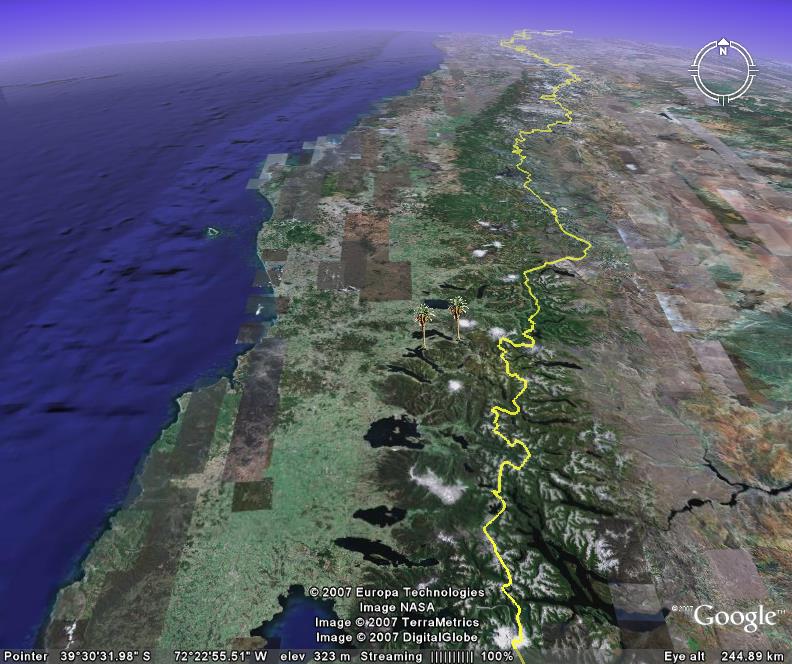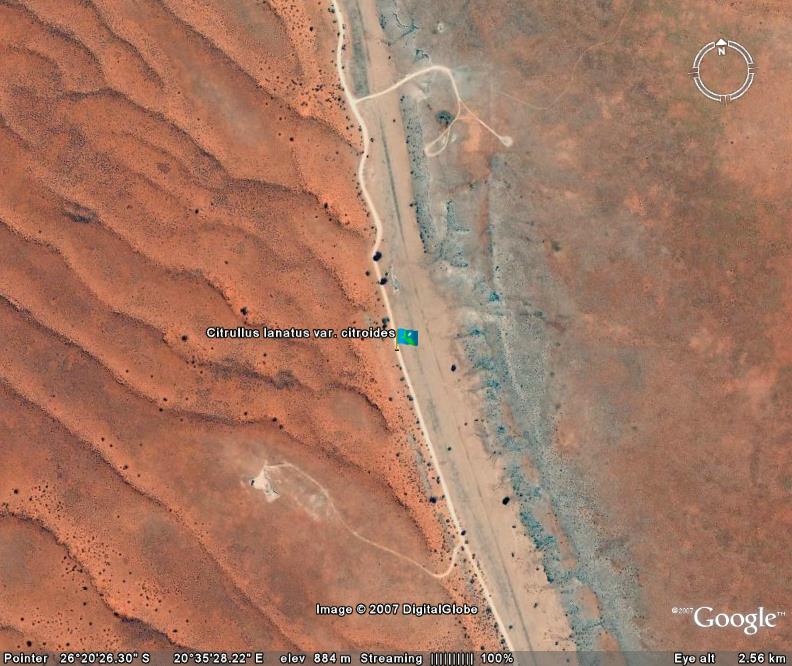A post in Google Earth Blog alerted me to the great efforts by staff and students at the Faculty of Agronomy and Forest Engineering at the Pontificia Universidad Catolica de Chile to geo-tag the specimens in their herbarium. They’ve produced a Google Earth kml file to show hundreds of collecting locations throughout the country. Below are the localities of Persea lingue, a congener of the avocado, though I’m not sure how closely related they are. It’s threatened, according to IUCN, and indeed there’s only a couple of specimens in the herbarium, quite near each other:
Watermelon: Out of Africa
Summer here in Rome tastes of watermelon. So, as the temperature outside hit the upper 30s today, it was great to sit in air-conditioned splendour in the office this lunchtime, eat a slice of cocomero and read a paper on the origin of the crop in the latest GRACE, which has just come out. Fenny Dane and Jiarong Liu at Auburn have looked in detail at chloroplast DNA from material collected all over Africa in an effort to reconstruct the history of both the familiar fruit (Citrullus lanatus var. lanatus) and the related tsanna or citron melon, which is a different botanical variety (var. citroides) of the same species. It turns out that the split of var. lanatus and var. citroides from a common ancestor (C. ecirrhosus, maybe) is ancient. The citron melon split off independently in the area of Swaziland and South Africa, while the wild precursor of the cultivated watermelon has its roots, as it were, on the other side of the continent, in Namibia. The picture below (courtesy of GBIF) shows why watermelon does ok in the Italian summer heat. Its natural habitat is pretty much desert (the record is for an accession in the US National Plant Germplasm System).
Scent of a strawberry
Wild strawberries smell good. Ingmar Bergman unavailable for comment.
Kutch’s wild ass and Important Plant Areas
I blogged about some recent additions to the list of World Heritage Sites a couple of days back, and now I’ve come across a potential new candidate, which should get in on the strength of its name alone: the Wild Ass Sanctuary in the Rann of Kutch. The wild ass in question is Equus hemionus khur, the Indian wild ass, a subspecies of the onager, the Asiatic wild ass. The khur’s habitat does sound fascinating:
The Rann, the last habitat of the wild ass (Equus hemionus khur) covering an area of 4954 sq. km is one of the most remarkable and unique landscapes of its kind in the world, which is considered as a transitional area between marine and terrestrial ecosystems. During the monsoons, while the entire area gets inundated, as many as 74 elevated plateaus stand out in the area. The sanctuary also houses 253 flowering plant species, 93 species of invertebrates and 33 species of mammals including the Khur sub-species of wild ass.
It would be great to have a protected area which is so strongly focused on the conservation of a wild relative of a domesticated animal. Wish there were more of them on the crop wild relative side. We’ve just heard that the international network of protected areas needs to do a better job of covering crop centres of origin and diversity. Now, Britain is hardly a centre of agrobiodiversity, but it does have a few crop wild relatives, so I wonder whether the British boffins who wrote the WWF report on protected areas and crop wild relatives had any input in selecting the just-announced Important Plant Areas (IPA) of the UK. I expect they tried their best, and the selection criteria do mention crop wild relatives, but it seems as if they were pretty much an afterthought:
The IPA project was conceived in Europe in response to the increasing rate of loss of the irreplaceable wealth of Europe’s wild flowers and habitats through rapid economic development, urbanisation, and habitat destruction. The IPA programme is a means of identifying and protecting the most important sites for wild plant and habitats in Europe. In addition to the protection this will offer to threatened habitats and species (higher, lower plants and fungi), IPAs will also offer protection to a wide range of species including medicinal plants, relatives of crop plants, veteran trees and many common but declining species.
UNESCO World Heritage Sites and agricultural biodiversity
Two of the newly-inscribed sites in the UNESCO World Heritage List caught my eye because of their agricultural biodiversity connections: both, interestingly, are in Europe. The first is the Lavaux vineyard terraces, 30 km of 1000-year-old agricultural landscape around Lake Geneva. The second is the primeval beech forest of the Carpathians, in Slovakia and Ukraine. However, I must admit that this second one only caught me eye by mistake, as it were. I thought it was in these forests that the last aurochs lived, but that was ignorance, pure ignorance on my part. It is the wisent that lives there, still. The last recorded aurochs died in 1627 in the royal forest of Jaktorow in Masovia, central Poland. Somewhere else entirely. But I wonder if there are any other wild relatives — of either livestock or crops — in the primeval Carpathian beech forest.

